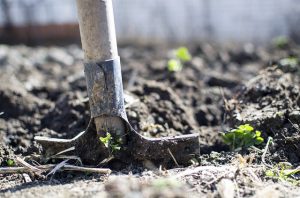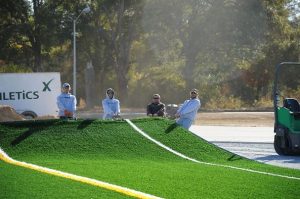Here is a step-by-step guide that will take you through the process of laying your own little patch of artificial grass in your garden. And, in no time, you can be the proud owner of a piece of lush, green lawn.
Preparing the Area
The first step is to prepare the area where you plan to lay your lawn. Clear the area of any grass or weeds growing in the area by spraying the area with a weed killer. You should do this at least two weeks before beginning your project so that all the vegetation in the area where you want to lay the lawn is killed off. This will ensure that all the vegetation is destroyed down till the roots.
Removing the Topsoil

If you plan to lay your artificial lawn over the soil, then remove the soil up to around 3-4 inches so that you have sufficient space for the new turf. You must then remove all the existing dead vegetation from the soil so that it is even and uniform.
If it has rained and the soil is soaked, then before you dig it up, allow it to dry, as digging the wet soil will cause it to slump. Once you have removed the topsoil by digging, try and level it out by using a tamp or simply walk over the ground. You can maintain a slight gradient, as this will help to improve the drainage.
Planning the Drainage
If your soil is permeable and drains well, then you will not have any problems with the drainage. However, if the turf is being laid over soil that does not drain out well, then you must take care of a few things like:
Ensure that you have a good drainage system and if the area does not have a good drainage facility, then you could consider installing a proper drainage system.
If your area gets very little rainfall, then providing small gaps of around 6-8 inches around the perimeter of the artificial lawn area will be sufficient.
Installing the Border
If there is no waterproofing present on the border along the perimeter of the lawn, then you must install waterproofing. This will keep the turf from separating or sagging in the long run. An effective option for waterproofing is to use a plastic bender board. Another option is to install a concrete curb around the perimeter, which is a more permanent solution. Ensure that the border does not jut out above the level of the grass or it can obstruct the drainage.
Adding a Weed Barrier

If you are worried that weeds will grow in between the artificial grass, then you can lay a geotextile barrier, which is a heavy, tightly woven lining the bottom of the area that has been dug. Although this is optional, it is still a good idea, as the barrier will also help to stop earthworms and gophers from digging through the artificial lawn. If you have a problem with rodents in your area, then you could consider installing a layer of rodent wire also.
However, if the problem of rodents is rampant, then it may be a good idea to have them removed by calling the pest control, otherwise, rodents can cause quite a bit of havoc.
Adding the Base Material
You can fill the area that has been dug with fine gravel, crushed rock or granite and fill the dug up area to around 3-4 inches. This will help to prevent sagging of the lawn and also helps in better drainage.
Moistening and Compaction of the Base

Moisten the sand or gravel lightly. This helps to lubricate the particles for compaction; however, take care not to over water. Compact the loose material into a strong base with the help of a roller compactor, hand tamp or plate compactor.
Rolling out the Artificial Lawn on the Side
While the base dries, you can unroll the artificial grass on the side. Since the artificial grass is transported in the form of rolls, it may take a couple of hours to restore its shape. Wait till the base is completely dry and then ensure that it is firm and smooth before you actually lay the grass on it. If the base is not completely smooth, then you should compact it further. If the base is lower than the level you require, then you may need to pour in another layer of material and compact it so that the surrounding surface and the artificial lawn are at the same level.
Installing the Lawn
Laying out the Lawn

With the help of another person, carefully lay the artificial turf over the base that you have prepared. Don’t drag the lawn over the base as the smooth surface may be disturbed. Install all the pieces of turf with the blades of grass facing the same direction, otherwise, your lawn will look messy and less natural.
Cutting the Grass
Cut the underside of the artificial grass wherever required depending on the shape of the area using a utility knife or a carpet cutter. Cut in such a way that there are no gaps.
Joining the Grass Strips Together
Some of the ways to seam the strips of turf together are:
- You can line two strips of grass together and fold the edges back and lay the artificial turf seaming material on the exposed base. Then cover the seaming material with the adhesive product and fold the strips over the seaming material and let it dry.
- You could lay a length of outdoor or seaming tape on the ground and then place two strips of grass on top of the tape.
- Secure the strips of grass with stakes, using 1 stake after every 3-inches.
Fastening the Perimeter of the Lawn
Using landscaping anchor pins or galvanized stakes that are around 4”-6”, fasten the artificial grass around the perimeter at around 6” intervals. Flatten them by hammering, but avoid hammering excessively, as this can cause dips in the lawn.
Adding Ballast or Infill

To ensure that the bristles are standing up properly, provide adequate cushioning for athletic activities and in order to weigh the grass down, most of the artificial lawns need additional particles. Add a thin layer ballast or infill material either by using a drop spreader or by hand. Smoothen the layer by using a rake and repeat the process until half of the blade length is covered by the material.
The most commonly used materials are:
- Washed silica sand. This is mainly used as ballast to weight down the lawn; however, if infill is required, the sand may not suffice.
- You can use black crumb rubber to support the grass blades and provide extra cushioning. However, the crumb rubber may not be suitable for installation on a slope or if you have pets, as it can become quite messy.
- Copper slag.
Brushing the Lawn
After putting in each layer of the infill material, brush the lawn using a broom or carpet rake and clear all the debris.
Watering the Lawn
Watering the lawn will help the ballast or infill to settle down. Check the lawn the next day and if you notice too much of the grass blade exposed or the lawn not cushiony enough, then you can add in another layer of infill. Once you are done, clear all the debris from the lawn’s surface.
By following the above steps, you can have your brand new artificial turf installed in your home in no time at all.
